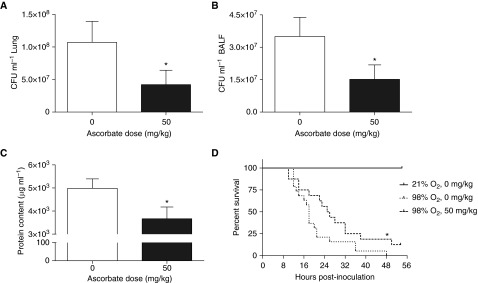Figure 1.
Ascorbic acid (AA) decreases hyperoxia-compromised bacterial clearance in mice. Male C57BL/6 mice, exposed to 98% O2 or higher for 48 hours, were inoculated with Pseudomonas aeruginosa (PA; 1 × 107 CFU) intratracheally. Mice were randomized to receive either AA (50 mg/kg) or saline intraperitoneally. Bronchoalveolar lavage fluid (BALF) and lung tissues were harvested 18 hours after infection. Number of viable bacteria in lungs (A) and BALF (B) were determined by plating serial dilutions of either homogenized lung tissues or BALF, respectively. The total protein content in BALF (C) was measured using the bicinchoninic acid assay (n = 21 mice per group). In another set of experiments, mice were observed for survival after inoculation with PA (n = 13–18 mice per group) (D). Data represent the mean ± SEM of at least four independent experiments. *P ≤ 0.05 compared with control mice.

